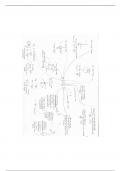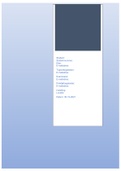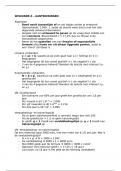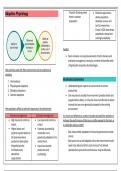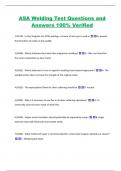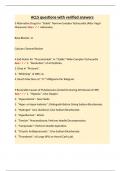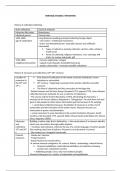PSYC 300
Chapter 12 – Substance Related Disorders
12.1 Alcohol Abuse and Dependence
- Alcohol dependence may include tolerance or withdrawal reactions.
People physically dependent on alcohol have more severe symptoms of the disorder
- Those who begin drinking early in life develop their first withdrawal symptoms in 30s or 40s.
Effects of abrupt withdrawal of alcohol in a chronic, heavy user may be dramatic body has
become accustomed to the drug.
Subjectively person is often anxious, depressed, weak, restless, and unable to sleep.
Tremors of the muscles (especially of small musculatures of the fingers, face, eyelids, lips, and
tongue may be marked)
Pulse, blood pressure, and temperature are elevated.
- In rare cases, a person who has heavily drunk for years may also experience delirium tremens (the DTs)
level of alcohol in the blood drops suddenly.
Delirium tremens: acute form of delirium caused by withdrawal of addictive substances.
o Also called “the shakes.”
Person becomes delirious, tremulous, hallucinates (primarily visual may be tactile).
Unpleasant active creatures (snakes, cockroaches, spiders, etc.) may appear crawling up the wall,
felt on person's body, or may fill the room.
Feverish, disoriented, and terrified person may claw frantically at their skin to get rid of the
feeling of animals.
Delirium and physiological paroxysms caused by withdrawal of alcohol indicate the drug is
addictive.
- Increased tolerance follows heavy, prolonged drinking.
Some alcohol abusers can drink litres of alcohol a day without showing drunkenness
Levels of alcohol in the blood are unexpectedly low after excessive drinking body adapts to
the drug and can process it more efficiently.
- Changes in the liver enzymes that metabolize alcohol can account to a small extent for tolerance
Most researchers now believe the CNS is implicated.
Research suggests tolerance results from changes in the number/sensitivity of GABA/glutamate
receptors
Withdrawal may be the result of increased activation in neural pathways to compensate for
alcohol's inhibitory effects in the brain.
When drinking stops, inhibitory effects of alcohol disappear resulting in state of
overexcitation.
- Tolerance is mostly due to physiological factors
- Response expectations (psychological) and the consequences of behaviour can have a direct influence on
tolerance and the effects of alcohol
Similarly, the development of addictions often reflects the interplay of biological and
psychological factors.
- Drinking patterns of people alcohol dependent indicate their drinking is out of control.
There is a need to drink daily and inability to stop or cut down despite repeated efforts to abstain
completely or to restrict drinking to certain periods of the day.
Alcoholics may go on binges, remaining intoxicated for two, three, or more days.
Alcoholics may consume a litre of alcohol at a time, suffer blackouts, have no memory of events
that took place during intoxication
The craving may be so overpowering that they are forced to ingest alcohol in a non-beverage
form (e.g., hair tonic)
- Drinking can cause social & occupational difficulties, trouble with family or friends, violent behaviour,
absences from work, loss of jobs, and arrests for intoxication or traffic accidents.
, - A person who abuses alcohol (vs. a person physically dependent on it) experiences negative social and
occupational effects from the drug but does not show tolerance, withdrawal, or compulsive drinking
patterns seen in alcohol dependent people.
Prevalence & Comorbidity Alcohol Abuse
- Study found about 3 in 4 people with alcohol dependence never received treatment.
- Prevalence rates were higher in men, younger cohorts, and whites.
Course was often chronic, with an average of four years for alcohol dependence
- U.S. survey over 10,000 adolescents (ages of 13 – 18) found 15% of adolescents (1 in 7) met criteria
for lifetime substance abuse.
Additional analyses indicated median age of onset for drug or alcohol abuse with dependence
was about 14 years old
Based on 2004 Canadian Addiction Survey:
o 22.6% of current alcohol drinkers exceeded low risk drinking guidelines stipulate no
more than two drinks per day
o 17.0% of current alcohol drinkers engaged in hazardous drinking.
o Strong gender differences exist hazardous drinking among 25.1% men and 8.9%
women.
- Prototypical heavy drinker in Canada is a young, not married, relatively well off financially male
- Problem drinking is comorbid with several personality disorders
Canadian researchers sought to identify genetic factors common to personality disorders and
alcohol misuse
Comorbid with mood & anxiety disorders, drug use, and schizophrenia.
Comorbidity is important to assess comorbid psychiatric disorders predict higher relapse rates
and less initial treatment improvement among dually diagnosed individuals with substance abuse
- Drinking is on the rise binge drinking among students remains a problem
9% increase in Canada overall in alcohol consumption increase was almost 2x as high (16%)
in British Columbia
Alcohol-related deaths increased to a similar degree, underscoring the dangers of excessive
drinking.
Other analyses found the heaviest drinking 10% of respondents accounted for 50% of overall
consumption
Nature of the Disorder
- Addictive disorders like alcohol abuse are considered & conceptualized according to models.
- Disease model view that problems like excessive drinking are due to vulnerabilities within a person
(e.g., a genetic predisposition, brain chemistry).
Disease (Medical) model: a conceptual model that maintains dysfunction stems from internal
biological processes and factors within the individual more likely to reflect psychiatry than
psychology.
Disease model reflects the medical model and announcement by the American Medical
Association that alcoholism is a disease (1954)
Disease model is endorsed belief in no cure possible and abstinence is indicated.
o Also promotes research for brain mechanisms implicated in addiction
- Moral model view that excessive drinking reflects personal failings and choices of individual.
Moral model: conceptual view that excessive drinking or other forms of addiction reflect personal
failings and personal choices of the afflicted individual because they have a deficit or moral
failing in their character.
- Models have clear implications for a host of other issues
Recovery
, Perceived likelihood of relapse
Role of personal responsibility
Self-directed change.
Course of the Disorder
- Initial beliefs about nature and course of alcoholism were strongly influenced by views and work of E.
Morton Jellinek.
Jellinek's emphasis on stages of alcoholism (emerge over time) is responsible for promoting the
disease model.
- Life histories of alcohol abusers were thought to have a common, downhill progression.
- Survey of 2,000 members in AA male alcohol abusers pass through four stages, beginning with social
drinking and progressing to a stage at which they live to drink.
- Available evidence does not always corroborate stage model.
Past of alcohol-dependent people show progression from alcohol abuse to dependence
o Data reveals fluctuations in drinking patterns, from heavy drinking to abstinence or
lighter drinking at others
o Patterns of maladaptive use of alcohol are variable heavy use of alcohol may be
restricted to weekends, or long periods of abstinence
o May be interspersed with binges of continual drinking for several weeks
o There is no single pattern of alcohol abuse.
- Evidence indicates Jellinek's account does not apply to women.
Difficulties with alcohol usually begin at a later age in women and after a stressful experience
(e.g., family crisis)
Time interval between onset of heavy drinking and alcohol abuse is briefer in women.
Women with drinking problems tend to be steady drinkers who drink alone and are less likely
than men to binge
Costs of Alcohol Abuse
- Clear regional differences in costs of alcohol abuse.
Example rates of hazardous alcohol drinking are high in Russia and has been established
indirectly that relatively low life expectancy of Russian men is attributable to hazardous alcohol
drinking.
Leon et al. (2007) found almost half of all deaths in working-aged men in a typical Russian
city is attributed to hazardous drinking.
- Most people who have a drinking problem do not seek professional help, but people who abuse alcohol
constitute a large proportion of new admissions to mental and general hospitals.
Problem drinkers use health services 4x more often than non-abusers, and their medical expenses
are 2x higher.
Suicide rate for alcohol abusers is much higher than the general population.
- Alcohol-related traffic fatalities has declined in Canada, but analyses of national data between 2000 and
2010 showed 56.7% of fatally injured drivers tested positive for alcohol, drugs, or both
In Canada drunk drivers kill an average of 3 - 4 people per day and injure 187 people
Alcohol increases the likelihood and severity of traffic accidents
- Prototypical drinking driver in Canada male between ages 25-34, drinks large amounts of alcohol on a
regular basis or is a social drinker who occasionally drinks heavily
Despite profile, social significance of drunk driving in teenagers is important.
6-to 19-year-olds made up 5.4% of Canadian population in 2003 but accounted for 23% of
pedestrian fatalities where driver had been drunk.
Authors called for nationwide requirement of zero blood alcohol for drivers 21 and under, greater
police powers, and more rigorous enforcement of existing legislation.
Chapter 12 – Substance Related Disorders
12.1 Alcohol Abuse and Dependence
- Alcohol dependence may include tolerance or withdrawal reactions.
People physically dependent on alcohol have more severe symptoms of the disorder
- Those who begin drinking early in life develop their first withdrawal symptoms in 30s or 40s.
Effects of abrupt withdrawal of alcohol in a chronic, heavy user may be dramatic body has
become accustomed to the drug.
Subjectively person is often anxious, depressed, weak, restless, and unable to sleep.
Tremors of the muscles (especially of small musculatures of the fingers, face, eyelids, lips, and
tongue may be marked)
Pulse, blood pressure, and temperature are elevated.
- In rare cases, a person who has heavily drunk for years may also experience delirium tremens (the DTs)
level of alcohol in the blood drops suddenly.
Delirium tremens: acute form of delirium caused by withdrawal of addictive substances.
o Also called “the shakes.”
Person becomes delirious, tremulous, hallucinates (primarily visual may be tactile).
Unpleasant active creatures (snakes, cockroaches, spiders, etc.) may appear crawling up the wall,
felt on person's body, or may fill the room.
Feverish, disoriented, and terrified person may claw frantically at their skin to get rid of the
feeling of animals.
Delirium and physiological paroxysms caused by withdrawal of alcohol indicate the drug is
addictive.
- Increased tolerance follows heavy, prolonged drinking.
Some alcohol abusers can drink litres of alcohol a day without showing drunkenness
Levels of alcohol in the blood are unexpectedly low after excessive drinking body adapts to
the drug and can process it more efficiently.
- Changes in the liver enzymes that metabolize alcohol can account to a small extent for tolerance
Most researchers now believe the CNS is implicated.
Research suggests tolerance results from changes in the number/sensitivity of GABA/glutamate
receptors
Withdrawal may be the result of increased activation in neural pathways to compensate for
alcohol's inhibitory effects in the brain.
When drinking stops, inhibitory effects of alcohol disappear resulting in state of
overexcitation.
- Tolerance is mostly due to physiological factors
- Response expectations (psychological) and the consequences of behaviour can have a direct influence on
tolerance and the effects of alcohol
Similarly, the development of addictions often reflects the interplay of biological and
psychological factors.
- Drinking patterns of people alcohol dependent indicate their drinking is out of control.
There is a need to drink daily and inability to stop or cut down despite repeated efforts to abstain
completely or to restrict drinking to certain periods of the day.
Alcoholics may go on binges, remaining intoxicated for two, three, or more days.
Alcoholics may consume a litre of alcohol at a time, suffer blackouts, have no memory of events
that took place during intoxication
The craving may be so overpowering that they are forced to ingest alcohol in a non-beverage
form (e.g., hair tonic)
- Drinking can cause social & occupational difficulties, trouble with family or friends, violent behaviour,
absences from work, loss of jobs, and arrests for intoxication or traffic accidents.
, - A person who abuses alcohol (vs. a person physically dependent on it) experiences negative social and
occupational effects from the drug but does not show tolerance, withdrawal, or compulsive drinking
patterns seen in alcohol dependent people.
Prevalence & Comorbidity Alcohol Abuse
- Study found about 3 in 4 people with alcohol dependence never received treatment.
- Prevalence rates were higher in men, younger cohorts, and whites.
Course was often chronic, with an average of four years for alcohol dependence
- U.S. survey over 10,000 adolescents (ages of 13 – 18) found 15% of adolescents (1 in 7) met criteria
for lifetime substance abuse.
Additional analyses indicated median age of onset for drug or alcohol abuse with dependence
was about 14 years old
Based on 2004 Canadian Addiction Survey:
o 22.6% of current alcohol drinkers exceeded low risk drinking guidelines stipulate no
more than two drinks per day
o 17.0% of current alcohol drinkers engaged in hazardous drinking.
o Strong gender differences exist hazardous drinking among 25.1% men and 8.9%
women.
- Prototypical heavy drinker in Canada is a young, not married, relatively well off financially male
- Problem drinking is comorbid with several personality disorders
Canadian researchers sought to identify genetic factors common to personality disorders and
alcohol misuse
Comorbid with mood & anxiety disorders, drug use, and schizophrenia.
Comorbidity is important to assess comorbid psychiatric disorders predict higher relapse rates
and less initial treatment improvement among dually diagnosed individuals with substance abuse
- Drinking is on the rise binge drinking among students remains a problem
9% increase in Canada overall in alcohol consumption increase was almost 2x as high (16%)
in British Columbia
Alcohol-related deaths increased to a similar degree, underscoring the dangers of excessive
drinking.
Other analyses found the heaviest drinking 10% of respondents accounted for 50% of overall
consumption
Nature of the Disorder
- Addictive disorders like alcohol abuse are considered & conceptualized according to models.
- Disease model view that problems like excessive drinking are due to vulnerabilities within a person
(e.g., a genetic predisposition, brain chemistry).
Disease (Medical) model: a conceptual model that maintains dysfunction stems from internal
biological processes and factors within the individual more likely to reflect psychiatry than
psychology.
Disease model reflects the medical model and announcement by the American Medical
Association that alcoholism is a disease (1954)
Disease model is endorsed belief in no cure possible and abstinence is indicated.
o Also promotes research for brain mechanisms implicated in addiction
- Moral model view that excessive drinking reflects personal failings and choices of individual.
Moral model: conceptual view that excessive drinking or other forms of addiction reflect personal
failings and personal choices of the afflicted individual because they have a deficit or moral
failing in their character.
- Models have clear implications for a host of other issues
Recovery
, Perceived likelihood of relapse
Role of personal responsibility
Self-directed change.
Course of the Disorder
- Initial beliefs about nature and course of alcoholism were strongly influenced by views and work of E.
Morton Jellinek.
Jellinek's emphasis on stages of alcoholism (emerge over time) is responsible for promoting the
disease model.
- Life histories of alcohol abusers were thought to have a common, downhill progression.
- Survey of 2,000 members in AA male alcohol abusers pass through four stages, beginning with social
drinking and progressing to a stage at which they live to drink.
- Available evidence does not always corroborate stage model.
Past of alcohol-dependent people show progression from alcohol abuse to dependence
o Data reveals fluctuations in drinking patterns, from heavy drinking to abstinence or
lighter drinking at others
o Patterns of maladaptive use of alcohol are variable heavy use of alcohol may be
restricted to weekends, or long periods of abstinence
o May be interspersed with binges of continual drinking for several weeks
o There is no single pattern of alcohol abuse.
- Evidence indicates Jellinek's account does not apply to women.
Difficulties with alcohol usually begin at a later age in women and after a stressful experience
(e.g., family crisis)
Time interval between onset of heavy drinking and alcohol abuse is briefer in women.
Women with drinking problems tend to be steady drinkers who drink alone and are less likely
than men to binge
Costs of Alcohol Abuse
- Clear regional differences in costs of alcohol abuse.
Example rates of hazardous alcohol drinking are high in Russia and has been established
indirectly that relatively low life expectancy of Russian men is attributable to hazardous alcohol
drinking.
Leon et al. (2007) found almost half of all deaths in working-aged men in a typical Russian
city is attributed to hazardous drinking.
- Most people who have a drinking problem do not seek professional help, but people who abuse alcohol
constitute a large proportion of new admissions to mental and general hospitals.
Problem drinkers use health services 4x more often than non-abusers, and their medical expenses
are 2x higher.
Suicide rate for alcohol abusers is much higher than the general population.
- Alcohol-related traffic fatalities has declined in Canada, but analyses of national data between 2000 and
2010 showed 56.7% of fatally injured drivers tested positive for alcohol, drugs, or both
In Canada drunk drivers kill an average of 3 - 4 people per day and injure 187 people
Alcohol increases the likelihood and severity of traffic accidents
- Prototypical drinking driver in Canada male between ages 25-34, drinks large amounts of alcohol on a
regular basis or is a social drinker who occasionally drinks heavily
Despite profile, social significance of drunk driving in teenagers is important.
6-to 19-year-olds made up 5.4% of Canadian population in 2003 but accounted for 23% of
pedestrian fatalities where driver had been drunk.
Authors called for nationwide requirement of zero blood alcohol for drivers 21 and under, greater
police powers, and more rigorous enforcement of existing legislation.


